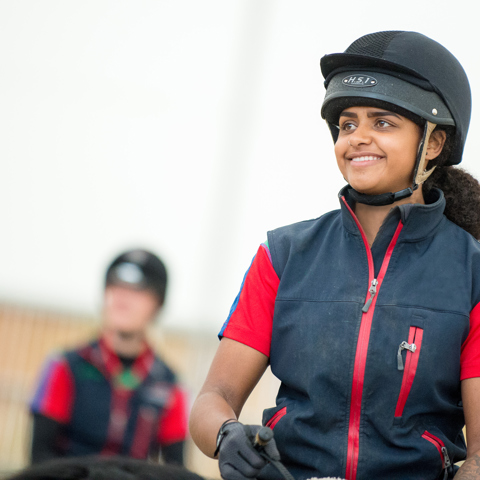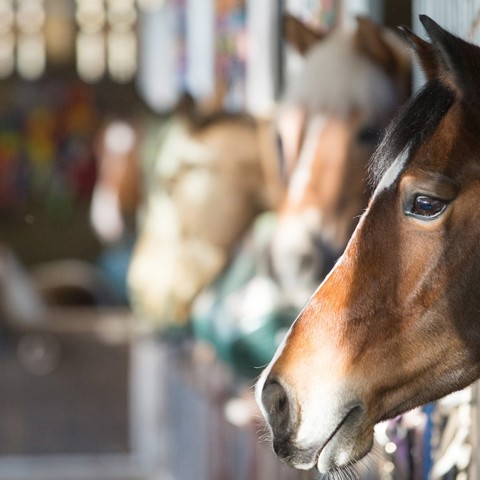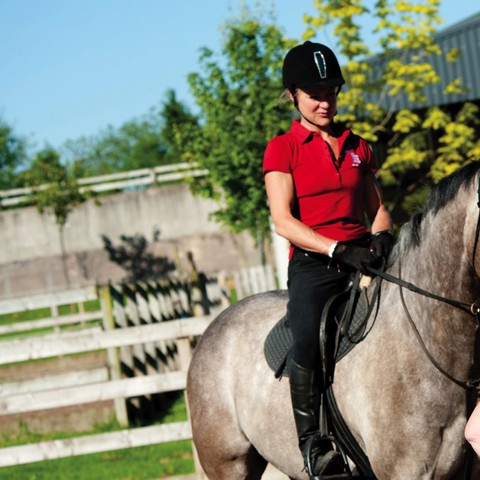You will be expected to handle all types and ages of horses safely and confidently, showing respect and consideration for all horses and any additional handlers. The assessment will be a combination of practical tasks and discussion and you will have opportunities to discuss your broad working knowledge of the equine industry. You will also deliver a training session to show your ability to impart your knowledge to others to support their development.
Download the assessment criteria for further detail.
1. Static and dynamic assessment of conformation
chevron-down
chevron-up
For this assessment you will analyse static and dynamic conformation, including limb conformation and foot balance. You will then discuss your analysis, the horse’s potential use and market value.
You will analyse two horses, one at a time. You will not be given any information about the horses. The horses may be of any age, type, breed, size and conformation. An assistant will be available to hold and trot up the horse as per your instructions which should be clear and polite. There will be a suitable outside area to observe the horses.
You will be expected to observe each horse from all angles, up close and from a distance. You will be required to age the horses. Possible areas for discussion include conformational strengths and weaknesses, condition, muscle development, straightness of movement, soundness, injuries and blemishes, and potential performance capability. Following your observations, you will discuss each horse’s possible use, conformational suitability for various disciplines and any factors that may affect this. You will make recommendations for the horse’s management and workload with the view to promote good health, welfare, fitness and longevity.
Finally, you will discuss the buying and selling of horses, vetting procedures and factors that contribute to the horse’s market value.
The assessment should last approximately 30 minutes.
2. Management and health of competition horses and evaluation of saddlery
chevron-down
chevron-up
This is a discussion-based assessment. You will discuss the management of a range of horses that you are likely to encounter during your professional career. You will then focus your discussion to competition horses and their management during long distance travel, including international travel. You will discuss the current legal requirements and considerations for travelling horses internationally, including biosecurity to prevent the spread of disease before, during and after travel and competition.
You should understand and be able to explain current Fédération Equestre Internationale (FEI) rules and recommendations with regards to drugs and medication for competition horses. You will also discuss the use of common over the counter and veterinary prescribed drugs and preparations for common ailments including the uses, costs, storage, administration, and contra-indications of such medications. There will be a range of drug packaging available to promote the discussion.
You will evaluate a range of diagnostic tests for the investigation of injuries and health concerns in horses. You should be able to discuss the strengths and weaknesses of the tests, when they are used and their reliability in diagnosis.
The saddlery section will assess your ability to evaluate the use of a wide variety of tack for different horses in commercial and competitive environments.
There will be a range of saddles, bridles, bridle work and training aids available for discussion. Discussion may include saddlery for all disciplines or the commercial environment, condition, age, value, replacement costs, quality, uses, availability and popularity.
The assessment should last approximately one hour, conducted individually or in pairs.
3. Horse condition, feeding and management
chevron-down
chevron-up
For this assessment you will showcase your ability to analyse a horse’s health, condition and muscle development in order to plan a horse’s management.
You will assess one horse in the stable. You will not be given any information about the horse. You will be required to carry out a static assessment only. The horse may be of any type, size and age and of any level of fitness and development.
Your analysis will cover such topics such as health, condition and fitness. You will be required to age the horse. From a static analysis you will be expected to estimate the level of fitness and assess the development of main muscular groups. You will not be required to discuss in detail the horse’s conformation strengths or weaknesses, unless you think it is directly affecting the horse’s health, condition or muscle development. Your evaluation will progress to the management of different types of horses with a specific focus on feeding and fitness.
Discussions surrounding the management of the horse and its fitness work will include:
- From out of work to participating across all disciplines to include planning and implementation of programmes to maintain and to develop fitness
- Problem solving
- Biomechanics
- Health issues
- Practical considerations
- Knowledge of performance requirements
Discussions surrounding the management of the horse and its feeding will include:
- From out of work to participation across all disciplines to include planning and implementation of feeding regimes to maintain health and performance
- Nutritional requirements
- Health issues
- Breeding stock
- Practical application in yards
- Riding of different sizes and disciplines
The assessment should last approximately one hour, conducted individually or in pairs.
4. Breeding
chevron-down
chevron-up
For this assessment you will confirm your understanding and knowledge surrounding the breeding of horses, their management and young horse handling. Although you may not choose to breed horses within your career, you should have a working knowledge of breeding processes and requirements for breeding stock.
You will assess one mare in the stable. You will not be given any information about the mare. The mare may be of any type, size, age and condition. You will be required to carry out a static assessment only. You will also age the mare.
You will assess the mare for its suitability for breeding and will discuss such topics such as its shape, weight, udder, conformation and behaviour, age and purpose of use of the mare and possible foal. You will evaluate the practicalities of putting the mare in foal, as well as a range of different types of horses and breeding programmes. Discussions will continue surrounding the ethics of breeding horses in different situations, different breeding processes and methods of handling young horses and the effect on development and behaviour.
The assessment should last approximately 40 minutes, conducted individually or in pairs.
5. Deliver training
chevron-down
chevron-up
For this assessment you will showcase your ability to deliver training to others on a Stage 4 care topic. The topic you will be asked to deliver will be chosen at random by your assessor, on the day of your assessment. The topic for your training session will be one of:
- How to assess a horse’s conformation
- How to apply a knee or hock bandage
- How to fit a double bridle
- The use and fitting of a training aid (may include, Market Harborough, bungees, draw reins, harbridge, De Gogue)
- How to check a dressage saddle for comfort
- Methods of restraint
You will not be required to bring a lesson plan to your assessment; however, we recommend you are prepared to deliver any of the topics listed above. Your training session should be suitable for a learner working towards BHS Stage 4. Your training session should last no more than 10 minutes. You may be asked to deliver to a fellow candidate or staff/volunteer at the centre.
6. Care and welfare topic discussion
chevron-down
chevron-up
Throughout your career you will be aware of new information, guidance and research that may influence your care and management of horses as ideas and technology advances. In this assessment you will demonstrate your knowledge in a chosen topic, demonstrating current industry thinking in this topic and be aware of a range of sources of information that has influenced your views. You will also demonstrate your presentation and communication skills to ensure you are confident communicating in the workplace; preparing you to be able to advise clients or deliver training and demonstrations.
For this assessment you will explore a topic of your choice relating to Stage 4 Care. For example, topics could come from within areas such as:
- Care and management of mares and youngstock
- Specialist tack for competition
- Nutrition
- Maintaining health and wellbeing in horses
- Health, management and fitness of competition horses
- Quality of life and euthanasia
- Equine learning theory
- Young horse handling
You will review a minimum of three sources that relate to your topic. Sources of evidence can be in the form of books, journals, magazines (for example, Equine Health), websites, expert testimony (expert opinion of an industry leading professional) or research articles. Only one expert testimony is permitted. The expert testimony should be recorded, and a recording brought to the assessment, for review from the panel if required.
You will present to a small group of up to three industry professionals (for example, BHS Assessor, veterinarian, farrier or proprietor).
Your presentation should last between 15-20 minutes. You have the option to present using software such as Microsoft PowerPoint, although this is not compulsory.
Following your presentation, the panel will have an opportunity to ask questions.
Please bring with you any supporting evidence and literature for possible review from the panel.
The assessment should last approximately 30 minutes and is assessed as a standalone assessment
Please note this assessment is held virtually via video call. If you would prefer a face-to-face assessment, please speak to the Education Team.
Entry requirements
chevron-down
chevron-up
- A minimum age of 18 years
- BHS Stage 4 Senior Yard Manager, or equivalent
- BHS Gold membership – Membership discounts apply for learners who are training for or taking BHS qualifications
- International students should be either International Full or International E-Members.
Recommended reading
chevron-down
chevron-up
- BHS Complete Horsemanship Volume 4
- The BHS Veterinary Manual
- The Horse in Motion
- Equine Injury Therapy and Rehabilitation
- Horses Inside Out Anatomy Poster Book Volume 1
- Horses Inside Out Anatomy Poster Book Volume 2
- How Your Horse Moves
- Horse Anatomy and Performance
- Veterinary Notes for Horse Owners
- No Fear, No Force
- Equine Exercise and Physiology
- Sport Horse Conformation
- AAEVT's Equine Manual for Veterinary Technicians
- FEI Clean Sport Initiative
- FEI Biosecurity guidance
- FEI International Movements Guidance





